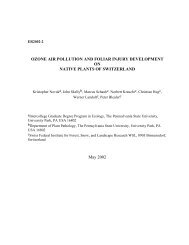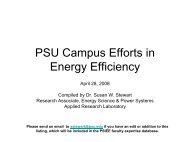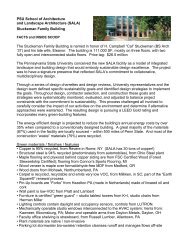Next-Generation Biofuels - Penn State Institutes of Energy and the ...
Next-Generation Biofuels - Penn State Institutes of Energy and the ...
Next-Generation Biofuels - Penn State Institutes of Energy and the ...
You also want an ePaper? Increase the reach of your titles
YUMPU automatically turns print PDFs into web optimized ePapers that Google loves.
10 NEXT-GENERATION BIOFUELS<br />
<br />
<br />
<br />
<br />
<br />
<br />
<br />
<br />
<br />
<br />
<br />
<br />
<br />
<br />
<br />
<br />
<br />
<br />
<br />
<br />
<br />
<br />
defining <strong>the</strong> technologies <strong>of</strong> <strong>the</strong> future for this industry. Six<br />
are under construction or planned for in Bay states: three<br />
in New York, two in <strong>Penn</strong>sylvania, <strong>and</strong> one in Maryl<strong>and</strong>.<br />
Not all are in <strong>the</strong> watershed.<br />
A collaboration involving <strong>the</strong> U.S. Department <strong>of</strong><br />
<strong>Energy</strong>, Conoco Phillips, <strong>and</strong> Iowa <strong>State</strong> University is also<br />
developing cellulosic technologies that will use gasification,<br />
pyrolysis, <strong>and</strong> fermentation to produce fuels from<br />
corn stalks, stems, leaves, o<strong>the</strong>r non-food agricultural<br />
residues, hardy grasses <strong>and</strong> fast-growing trees. In addition<br />
to <strong>the</strong> production <strong>of</strong> cellulosic ethanol, emerging technology<br />
will soon support a wide range <strong>of</strong> bi<strong>of</strong>uels including<br />
biobutanol, renewable diesel, <strong>and</strong> biogasoline <strong>and</strong> jet fuel<br />
(see Figure 5).<br />
Government grants, loans, loan guarantees <strong>and</strong> tax<br />
credits — coupled with Renewable Fuel St<strong>and</strong>ards (see<br />
Sidebar, page 9) <strong>and</strong> cutting edge research at universities<br />
<strong>and</strong> government labs — are also boosting <strong>the</strong> development<br />
<strong>of</strong> cellulosic bi<strong>of</strong>uels. The U.S. Department <strong>of</strong> <strong>Energy</strong><br />
is investing up to $375 million in three new Bioenergy<br />
Research Centers that will accelerate <strong>the</strong> development<br />
<strong>of</strong> cellulosic ethanol <strong>and</strong> o<strong>the</strong>r bi<strong>of</strong>uels, as part <strong>of</strong> <strong>the</strong><br />
national “Twenty in Ten” initiative to reduce U.S. gasoline<br />
consumption by 20 percent within 10 years. The U.S.<br />
Department <strong>of</strong> <strong>Energy</strong> is also investing $385 million for<br />
six cellulosic bio-refinery projects over <strong>the</strong> next four years.<br />
When fully operational, <strong>the</strong> bio-refineries are expected<br />
to produce more than 130 million gallons <strong>of</strong> cellulosic<br />
ethanol per year.<br />
The adoption <strong>of</strong> a low-carbon fuel st<strong>and</strong>ard in<br />
California to reduce <strong>the</strong> carbon intensity <strong>of</strong> <strong>the</strong> state’s<br />
transportation fuel use 10 percent by 2020 will fur<strong>the</strong>r<br />
advance <strong>the</strong> development <strong>of</strong> cellulosic bi<strong>of</strong>uels. O<strong>the</strong>r<br />
states may follow, only fur<strong>the</strong>ring <strong>the</strong> dem<strong>and</strong>.<br />
Positioned to Lead<br />
The Chesapeake Bay region is well positioned to take<br />
leadership in this revolutionary shift to greener, renewable<br />
fuels, <strong>and</strong> to enjoy its economic <strong>and</strong> environmental<br />
benefits.<br />
A number <strong>of</strong> diverse feedstocks can be grown in <strong>the</strong><br />
Bay region as sustainable crops for cellulosic bi<strong>of</strong>uels<br />
throughout <strong>the</strong> year <strong>and</strong> transported at low cost to major<br />
East Coast energy markets. A large number <strong>of</strong> universities<br />
<strong>and</strong> research institutes in <strong>the</strong> region are already working<br />
on cellulosic bi<strong>of</strong>uels, <strong>and</strong> many private companies are<br />
willing to partner <strong>and</strong> develop competitive technologies.<br />
This research will not only produce a variety <strong>of</strong> bi<strong>of</strong>uels<br />
such as ethanol, butanol, biodiesel <strong>and</strong> biohydrogen,







